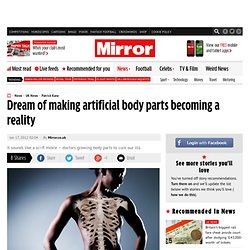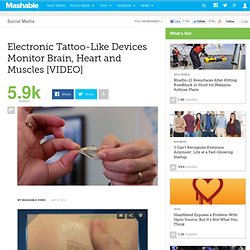

Real-time Discovery Engine - YourVersion: Discover Your Version of the Web™ Wearable robot puts paralysed legs through their paces. This article was taken from the February 2012 issue of Wired magazine.

Be the first to read Wired's articles in print before they're posted online, and get your hands on loads of additional content by subscribing online. This is the true integration of man and machine," says Eythor Bender, CEO of Ekso Bionics, a Californian research lab that has developed an intelligent "wearable robot". Bender and his team based the Ekso on a decade of bionics research by the US military. Its motorised leg braces let soldiers carry 90kg loads over long distances by anticipating the wearer's movement and transferring weight to the exoskeleton frame. The same principles allow paraplegics to walk with motorised legs, by responding to gestures made above the waist.
Its adjustable titanium frame encases the legs, with straps around the waist, shoulders and thighs, and a computer with two batteries sits as a backpack, powering four electromechanical motors that propel the legs. Connecting to the brain: Thinking about it. Water Scarce After the Apocalypse? Install These Water-Conserving Cyborg Internal Organs. Virtual reality posts on CNET. Real-time Discovery Engine - YourVersion: Discover Your Version of the Web™ CES: A laptop that follows your eyes - 1/13. Dream of making artificial body parts becoming a reality. It sounds like a sci-fi movie – doctors growing body parts to cure our ills.

But thanks to incredible breakthroughs, bionic repairs for humans are fast becoming a reality. Experts yesterday revealed they are perfecting “off the shelf” blood vessels, which could revolutionise treatment of heart attacks and strokes. If the Cambridge University blood vessel team is successful, patients could be spared major operations.
The test tube vessels may also treat kidney dialysis patients and repair injuries. And because the patient’s own skin cells are used, there is less chance of rejection. Professor Jeremy Pearson, of the British Heart Foundation, said: “This is very advanced. Here are other ways science is giving nature a helping hand... Experts are working on a cure for blindness - and have taken huge strides towards their goal. Miikka Terho, 46, from Finland, who suffered an inherited form of blindness called retinitis pigmentosa, was fitted with an experimental chip behind his retina in Germany. Artificial Super-Skin Could Transform Phones, Robots and Artificial Limbs.
Touch sensitivity on gadgets and robots is nothing new.

A few strategically placed sensors under a flexible, synthetic skin and you have pressure sensitivity. Add a capacitive, transparent screen to a device and you have touch sensitivity. However, Stanford University’s new “super skin” is something special: a thin, highly flexible, super-stretchable, nearly transparent skin that can respond to touch and pressure, even when it’s being wrung out like a sponge. The brainchild of Stanford University Associate Professor of chemical engineering Zhenan Bao, this “super skin” employs a transparent film of spray-on, single-walled carbon nanotubes that sit in a thin film of flexible silicon, which is then sandwiched between more silicon.
SEE ALSO: Humanoid Robot Charges Up, Takes a Load Off [VIDEOS] This unique makeup allows the malleable skin to measure force response even as it’s being stretched, or “squeezed like a sponge.” Electronic Tattoo-Like Devices Monitor Brain, Heart and Muscles. We might one day be able to monitor our bodies' internal functions — and prevent things like epileptic seizures before they happen — using a flexible circuit attached to the surface of skin.

The National Science Foundation announced Monday that researchers are working on a prototype tattoo-like device that can detect heart, muscle and brain activity. Tiny curly wires in a flexible membrane make up these devices and work better than conventional hard, brittle circuits, because body tissue itself is soft and pliable. "We're trying to bridge that gap, from silicon, wafer-based electronics to biological, 'tissue-like' electronics, to really blur the distinction between electronics and the body," said materials scientist John Rogers from the University of Illinois Urbana-Champaign. "As the skin moves and deforms, the circuit can follow those deformations in a completely noninvasive way.
" Paralysed woman drinks coffee with thought-guided robot arm. Voicegrams transform brain activity into words. Biggest Scientific Breakthroughs of 2011.